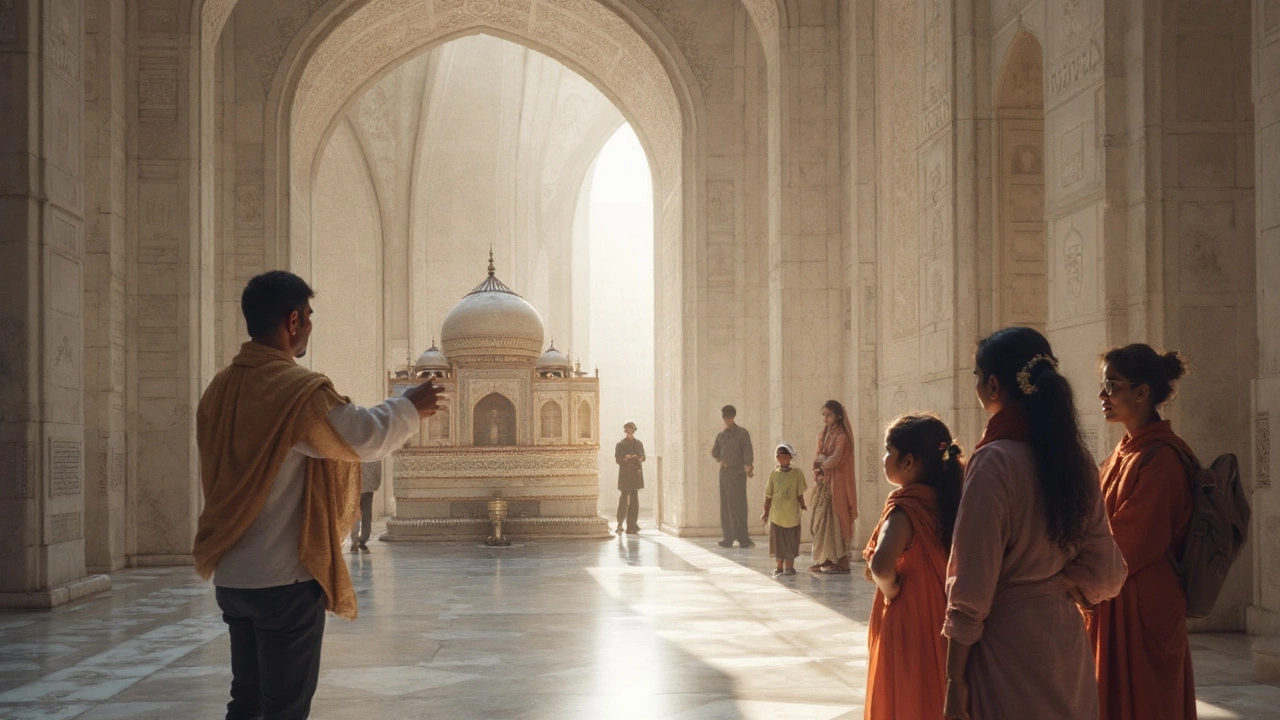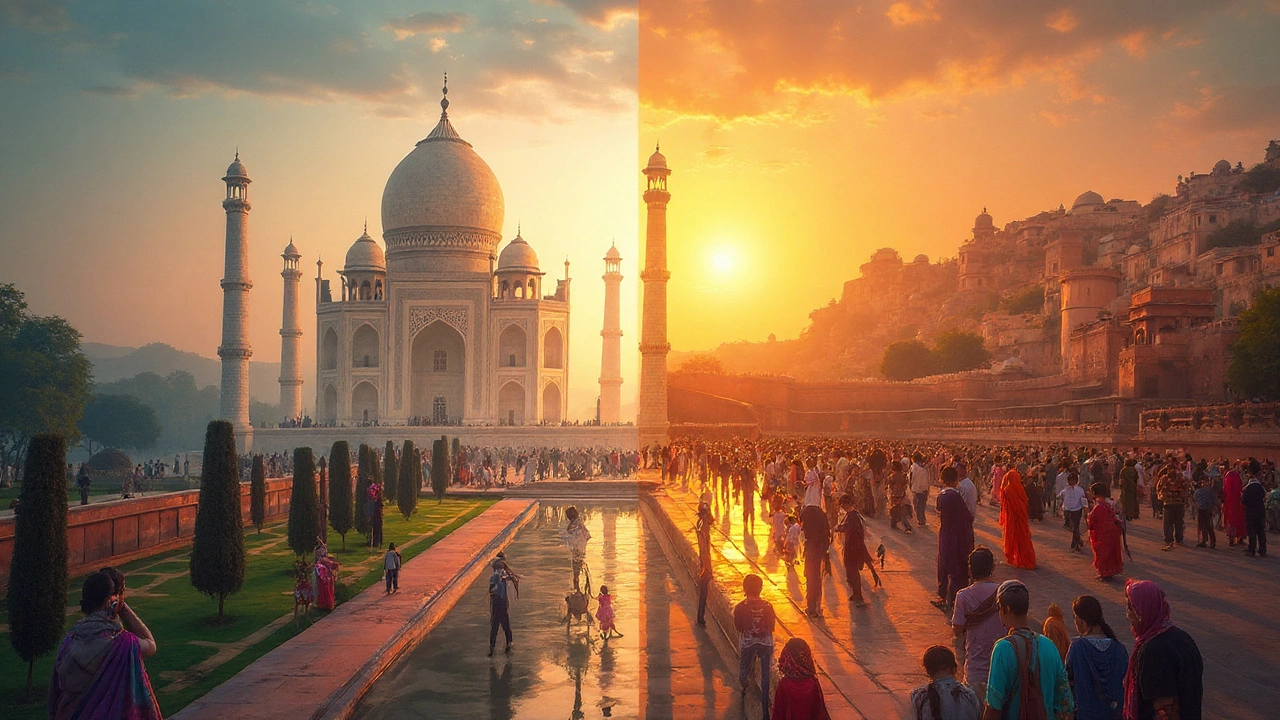Taj Mahal Visitor Quiz
1. In which year was the Taj Mahal completed?
2. What is the primary material used for the Taj Mahal?
3. Which garden offers the best sunrise view of the Taj Mahal?
4. Approximately how many visitors did the Taj Mahal receive in FY 2023‑24?
5. What UNESCO status does the Taj Mahal hold?
Taj Mahal is a white marble mausoleum on the banks of the Yamuna River in Agra, built in the 17th century as a tribute of love.
Quick Snapshot
- Annual domestic + foreign visitors: ~9 million (2023‑2024)
- UNESCO World Heritage Site since 1983
- Peak season: October to March
- Entry fee (foreign): INR 1,300; Indian citizens: INR 50
- Best view: sunrise from the Mehtab Bagh garden
Why the Taj Mahal Ranks #1
The numbers speak for themselves. According to the Ministry of Tourism, the monument recorded 8.9million visitors in the fiscal year 2023‑24, outpacing other heritage sites by a margin of over 3million. Its iconic silhouette appears on everything from postage stamps to airline logos, reinforcing its global brand.
Beyond sheer footfall, the Taj Mahal benefits from a perfect blend of heritage status, architectural brilliance, and modern visitor infrastructure. Being a UNESCO World Heritage Site means it receives international conservation funds, which keep the marble gleaming and the surrounding gardens manicured. Those factors together make it the most visited and most photographed location in India.
History, Architecture, and Symbolism
Commissioned by Emperor Shah Jahan in 1632, the Taj Mahal took over 20years and the labor of an estimated 20,000 artisans to complete. Its main dome rises 73meters, surrounded by four lesser domes and four towering minarets, each 40meters tall. The structure employs pure white Makrana marble, inlaid with semi‑precious stones forming calligraphic verses from the Quran.
Architecturally, the monument epitomises Mughal synthesis: Persian garden layouts, Indian stone‑carving techniques, and Central Asian arch designs co‑exist under a single roof. The Indian Heritage narrative highlights how the Taj acts as a cultural bridge, drawing tourists from every continent while teaching local artisans preservation skills.
Visitor Experience: What to See and When
First‑time travelers should allocate at least two hours: one for the main mausoleum and another for the surrounding gardens. Key viewpoints include:
- Western Gate: offers the classic reflection of the Taj on the pool.
- Mehtab Bagh: a moon‑lit garden opposite the river, perfect for sunrise shots.
- East Gate: provides an up‑close look at marble ornamentation.
Peak crowds arrive between 10am and 2pm. To beat the rush, book tickets online for the 9am slot or visit after sunset when the monument is illuminated (a 30‑minute light show).

How It Stacks Up Against Other Top Sites
| Attraction | Annual Visitors (millions) | UNESCO Status | Year Completed |
|---|---|---|---|
| Taj Mahal | 8.9 | Yes | 1653 |
| Agra Fort | 2.3 | Yes | 1565 |
| Jaipur - Amber Fort | 2.0 | No | 1592 |
| Kerala Backwaters (Alleppey) | 1.8 | No | Natural |
The table makes it clear: the Taj Mahal draws nearly four times the crowd of the next‑best heritage site, Agra Fort. Its UNESCO designation, combined with a well‑preserved 17th‑century architectural ensemble, explains the differential.
Related Attractions You Can Pair With a Taj Visit
Because Agra sits on the historic Grand Trunk Road, a day trip can easily include:
- Agra Fort - a red‑sandstone fortress offering a glimpse into Mughal military life.
- Fatehpur Sikri - a UNESCO‑listed ghost city just 40km away, showcasing Shah Jahan’s architectural ambition.
- Mehtab Bagh - the moon‑lit garden opposite the Taj, ideal for portraits.
Travel agencies often bundle these three spots into a “Golden Triangle” package that also includes Delhi’s Red Fort and Jaipur’s Pink City, giving tourists a comprehensive Mughal‑era itinerary.
Practical Tips for a Smooth Trip
- Booking tickets: Use the official Tourist Information System website to reserve entry slots and avoid long queues.
- Dress code: Modest clothing is advised; sleeves and trousers are recommended for security checks.
- Guides: A licensed guide (costing around INR 300 per hour) adds context about Mughal poetry and marble restoration.
- Transport: The Agra‑Delhi Expressway offers a 2‑hour bus ride from Delhi; a private car can stop at Fatehpur Sikri on the way.
- Photography: No flash inside the mausoleum; use a tripod for sunrise shots from Mehtab Bagh.
Following these pointers ensures you enjoy the site without the typical hassles of crowds, heat, or ticket scams.
Impact on India’s Tourism Economy
Data from the Tourist Arrivals Statistics shows that foreign visitors to the Taj Mahal contributed approximately USD 1.2billion in 2023‑24. This revenue fuels local hospitality jobs, supports artisan guilds that craft marble inlay, and finances conservation projects overseen by the Ministry of Tourism.
Moreover, the monument’s fame spurs indirect tourism: visitors often extend their stay to explore nearby textile markets, street food stalls, and river cruises on the Yamuna. The ripple effect illustrates why the Taj Mahal isn’t just a picture‑perfect stop-it’s an economic engine.
Future Outlook: Preservation and Visitor Management
Climate‑induced air pollution threatens the marble’s pristine whiteness. The Ministry of Tourism, together with UNESCO, has launched a “Clean Air” initiative that monitors particulate matter around Agra and funds anti‑soot cleaning every six months. For visitors, this means the monument will stay as radiant as it was centuries ago.
To balance preservation with demand, a timed‑entry system is being expanded. By 2026, the site aims to cap daily footfall at 12,000, with an online reservation window opening two weeks in advance. This strategy mirrors successful models employed at the Great Wall of China and Machu Picchu.
The Taj Mahal thus remains India’s number‑one tourist magnet, marrying timeless beauty with modern stewardship.

Frequently Asked Questions
When is the best time to visit the Taj Mahal?
The ideal window is between October and March when the weather is cool and the sky is clear. Sunrise offers soft lighting and thinner crowds, while evening light shows provide a magical atmosphere.
How much does it cost to enter for an Indian citizen?
Indian citizens pay INR50 for the main complex, plus INR30 for the garden area. A senior citizen (60+) receives a 50% discount.
Is photography allowed inside the mausoleum?
Photography is permitted, but flash and tripods are prohibited to protect the marble. External shots from the South, West, and East gates are unrestricted.
Can I combine a Taj Mahal visit with a trip to Agra Fort?
Yes. Both sites are within a 2‑kilometre radius, and many tour operators offer a combined ticket that includes a guided walk between the two.
What safety measures are in place for visitors?
Security checks at every entry point, CCTV monitoring, and a resident police outpost ensure safety. During peak season, additional staff manage crowd flow and first‑aid stations are on site.
How does the Taj Mahal contribute to the local economy?
Visitor spending supports hotels, restaurants, transport services, and thousands of artisans who produce marble inlay, textiles, and souvenirs. In 2023‑24, the site generated roughly USD1.2billion in foreign exchange earnings.
